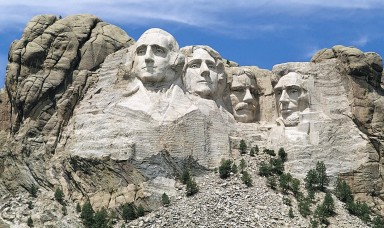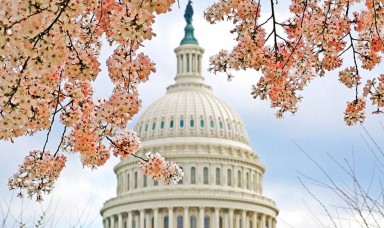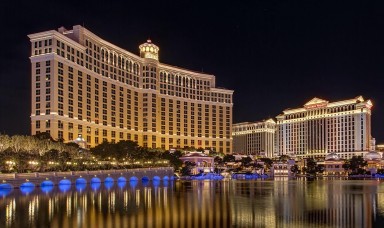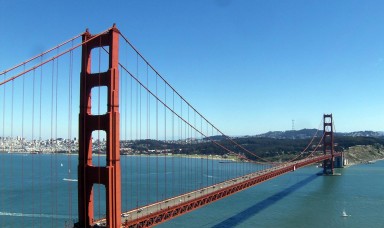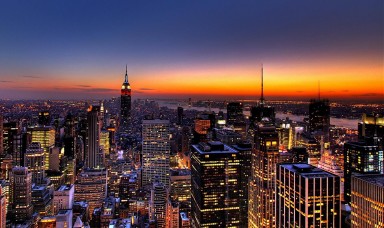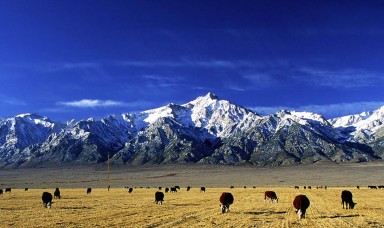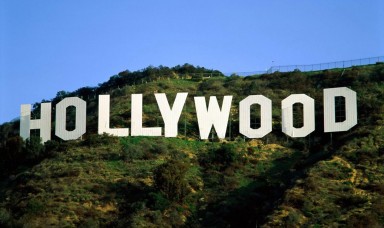 United States
United States
The United States of America (USA), commonly referred to as the United States (US), America or simply the States, is a federal republic consisting of 50 states and a federal district. The 48 contiguous states and the federal district of Washington, D.C., are in central North America between Canada and Mexico.
- GEOGRAPHICAL DATA
- DEMOGRAPHICS
- POLITICAL DIVISIONS
- ECONOMY
- CULTURE
The land area of the contiguous United States is 2,959,064 square miles (7,663,941 km2). Alaska, separated from the contiguous United States by Canada, is the largest state at 663,268 square miles (1,717,856 km2). Hawaii, occupying an archipelago in the central Pacific, southwest of North America, is 10,931 square miles (28,311 km2) in area.
The United States is the world’s third or fourth largest nation by total area (land and water), ranking behind Russia and Canada and just above or below China. The ranking varies depending on how two territories disputed by China and India are counted and how the total size of the United States is measured: calculations range from 3,676,486 square miles (9,522,055 km2) to 3,717,813 square miles (9,629,091 km2) to 3,794,101 square miles (9,826,676 km2). Measured by only land area, the United States is third in size behind Russia and China, just ahead of Canada.
The coastal plain of the Atlantic seaboard gives way further inland to deciduous forests and the rolling hills of the Piedmont. The Appalachian Mountains divide the eastern seaboard from the Great Lakes and the grasslands of the Midwest. The Mississippi–Missouri River, the world’s fourth longest river system, runs mainly north–south through the heart of the country. The flat, fertile prairie of the Great Plains stretches to the west, interrupted by a highland region in the southeast.
The Rocky Mountains, at the western edge of the Great Plains, extend north to south across the country, reaching altitudes higher than 14,000 feet (4,300 m) in Colorado. Farther west are the rocky Great Basin and deserts such as the Chihuahua and Mojave. The Sierra Nevada and Cascade mountain ranges run close to the Pacific coast, both ranges reaching altitudes higher than 14,000 feet (4,300 m). The lowest and highest points in the continental United States are in the state of California, and only about 80 miles (130 km) apart. At 20,320 feet (6,194 m), Alaska’s Mount McKinley is the tallest peak in the country and in North America. Active volcanoes are common throughout Alaska’s Alexander and Aleutian Islands, and Hawaii consists of volcanic islands. The supervolcano underlying Yellowstone National Park in the Rockies is the continent’s largest volcanic feature.
The United States, with its large size and geographic variety, includes most climate types. To the east of the 100th meridian, the climate ranges from humid continental in the north to humid subtropical in the south. The southern tip of Florida is tropical, as is Hawaii. The Great Plains west of the 100th meridian are semi-arid. Much of the Western mountains are alpine. The climate is arid in the Great Basin, desert in the Southwest, Mediterranean in coastal California, and oceanic in coastal Oregon and Washington and southern Alaska. Most of Alaska is subarctic or polar. Extreme weather is not uncommon—the states bordering the Gulf of Mexico are prone to hurricanes, and most of the world’s tornadoes occur within the country, mainly in the Midwest’s Tornado Alley.
The U.S. ecology is considered “megadiverse”: about 17,000 species of vascular plants occur in the contiguous United States and Alaska, and over 1,800 species of flowering plants are found in Hawaii, few of which occur on the mainland. The United States is home to more than 400 mammal, 750 bird, and 500 reptile and amphibian species. About 91,000 insect species have been described.
There are 58 national parks and hundreds of other federally managed parks, forests, and wilderness areas. Altogether, the government owns 28.8% of the country’s land area. Most of this is protected, though some is leased for oil and gas drilling, mining, logging, or cattle ranching; 2.4% is used for military purposes.
The U.S. Census Bureau estimates the country’s population now to be 317,546,000, including an approximate 11.2 million illegal immigrants. The U.S. population almost quadrupled during the 20th century, from about 76 million in 1900. The third most populous nation in the world, after China and India, the United States is the only major industrialized nation in which large population increases are projected.
With a birth rate of 13 per 1,000, 35% below the world average, its population growth rate is positive at 0.9%, significantly higher than those of many developed nations. In fiscal year 2012, over one million immigrants (most of whom entered through family reunification) were granted legal residence. Mexico has been the leading source of new residents since the 1965 Immigration Act. China, India, and the Philippines have been in the top four sending countries every year. Nine million Americans identify as homosexual, bisexual or transgender, making up less than four percent of the population. A 2010 survey found that seven percent of men and eight percent of women identified as gay, lesbian or bisexual.
The United States has a very diverse population—31 ancestry groups have more than one million members. White Americans are the largest racial group; German Americans, Irish Americans, and English Americans constitute three of the country’s four largest ancestry groups. Black Americans are the nation’s largest racial minority and third largest ancestry group. Asian Americans are the country’s second largest racial minority; the three largest Asian American ethnic groups are Chinese Americans, Filipino Americans, and Indian Americans.
In 2010, the U.S. population included an estimated 5.2 million people with some American Indian or Alaska Native ancestry (2.9 million exclusively of such ancestry) and 1.2 million with some native Hawaiian or Pacific island ancestry (0.5 million exclusively). The census counted more than 19 million people of “Some Other Race” who were “unable to identify with any” of its five official race categories in 2010.
The population growth of Hispanic and Latino Americans (the terms are officially interchangeable) is a major demographic trend. The 50.5 million Americans of Hispanic descent are identified as sharing a distinct “ethnicity” by the Census Bureau; 64% of Hispanic Americans are of Mexican descent. Between 2000 and 2010, the country’s Hispanic population increased 43% while the non-Hispanic population rose just 4.9%. Much of this growth is from immigration; in 2007, 12.6% of the U.S. population was foreign-born, with 54% of that figure born in Latin America.
Fertility is also a factor; in 2010 the average Hispanic (of any race) woman gave birth to 2.35 children in her lifetime, compared to 1.97 for non-Hispanic black women and 1.79 for non-Hispanic white women (both below the replacement rate of 2.1). Minorities (as defined by the Census Bureau as all those beside non-Hispanic, non-multiracial whites) constituted 36.3% of the population in 2010, and over 50% of children under age one, and are projected to constitute the majority by 2042. This contradicts the report by the National Vital Statistics Reports, based on the U.S. census data, which concludes that, 54% (2,162,406 out of 3,999,386 in 2010) of births were non-Hispanic white.
About 82% of Americans live in urban areas (including suburbs); about half of those reside in cities with populations over 50,000. In 2008, 273 incorporated places had populations over 100,000, nine cities had more than one million residents, and four global cities had over two million (New York City, Los Angeles, Chicago, and Houston).
There are 52 metropolitan areas with populations greater than one million. Of the 50 fastest-growing metro areas, 47 are in the West or South. The metro areas of Dallas, Houston, Atlanta, and Phoenix all grew by more than a million people between 2000 and 2008.
The United States is a federal union of 50 states. The original 13 states were the successors of the 13 colonies that rebelled against British rule. Early in the country’s history, three new states were organized on territory separated from the claims of the existing states: Kentucky from Virginia; Tennessee from North Carolina; and Maine from Massachusetts. Most of the other states have been carved from territories obtained through war or purchase by the U.S. government. One set of exceptions includes Vermont, Texas, and Hawaii: each was an independent republic before joining the union. During the American Civil War, West Virginia broke away from Virginia. The most recent state—Hawaii—achieved statehood on August 21, 1959. The states do not have the right to unilaterally secede from the union.
The states compose the vast bulk of the U.S. land mass. The District of Columbia is a federal district which contains the capital of the United States, Washington D.C. The United States also possesses five major overseas territories: Puerto Rico and the United States Virgin Islands in the Caribbean; and American Samoa, Guam, and the Northern Mariana Islands in the Pacific. Those born in the major territories are birthright U.S. citizens except Samoans. Samoans born in American Samoa are born U.S. nationals, and may become naturalized citizens. American citizens residing in the territories have fundamental constitutional protections and elective self-government, with a territorial Member of Congress, but they do not vote for president as states. Territories have personal and business tax regimes different from that of states.
The United States also observes tribal sovereignty of the Native Nations. Though reservations are within state borders, the reservation is a sovereign. While the United States recognizes this sovereignty, other countries may not.
The United States has a capitalist mixed economy which is fueled by abundant natural resources and high productivity. According to the International Monetary Fund, the U.S. GDP of $17.1 trillion constitutes 22% of the gross world product at market exchange rates and over 19% of the gross world product at purchasing power parity (PPP). Though larger than any other nation’s, its national GDP was about 5% smaller at PPP in 2011 than the European Union’s, whose population is around 62% higher. The country ranks ninth in the world in nominal GDP per capita and sixth in GDP per capita at PPP. The U.S. dollar is the world’s primary reserve currency.
The United States is the largest importer of goods and second largest exporter, though exports per capita are relatively low. In 2010, the total U.S. trade deficit was $635 billion. Canada, China, Mexico, Japan, and Germany are its top trading partners. In 2010, oil was the largest import commodity, while transportation equipment was the country’s largest export. China is the largest foreign holder of U.S. public debt.
In 2009, the private sector was estimated to constitute 86.4% of the economy, with federal government activity accounting for 4.3% and state and local government activity (including federal transfers) the remaining 9.3%. While its economy has reached a postindustrial level of development and its service sector constitutes 67.8% of GDP, the United States remains an industrial power. The leading business field by gross business receipts is wholesale and retail trade; by net income it is manufacturing.
Chemical products are the leading manufacturing field. The United States is the third largest producer of oil in the world, as well as its largest importer. It is the world’s number one producer of electrical and nuclear energy, as well as liquid natural gas, sulfur, phosphates, and salt. While agriculture accounts for just under 1% of GDP, the United States is the world’s top producer of corn and soybeans. The National Agricultural Statistics Service maintains agricultural statistics for products that include; peanuts, Oats, Rye, Wheat, Rice, Cotton, corn, barley, hay, sunflowers, and oilseeds. In addition, the United States Department of Agriculture (USDA) provides livestock statistics regarding beef, poultry, pork, along with dairy products. The National Mining Association provides data pertaining to coal and minerals that include; beryllium, copper, lead, magnesium, zinc, titanium and others. In the franchising business model, McDonald’s and Subway are the two most recognized brands in the world. Coca-Cola is the most recognized soft drink company in the world.
Consumer spending comprises 71% of the U.S. economy in 2013. In August 2010, the American labor force consisted of 154.1 million people. With 21.2 million people, government is the leading field of employment. The largest private employment sector is health care and social assistance, with 16.4 million people. About 12% of workers are unionized, compared to 30% in Western Europe. The World Bank ranks the United States first in the ease of hiring and firing workers. The United States is the only advanced economy that that does not guarantee its workers paid vacation and is one of just a few countries in the world without paid family leave as a legal right, with the others being Papua New Guinea, Suriname and Liberia. In 2009, the United States had the third highest labor productivity per person in the world, behind Luxembourg and Norway. It was fourth in productivity per hour, behind those two countries and the Netherlands.
The 2008-2012 global recession had a significant impact on the United States. It brought high unemployment (which has been decreasing but remains above pre-recession levels), along with low consumer confidence, the continuing decline in home values and increase in foreclosures and personal bankruptcies, an escalating federal debt crisis, inflation, and rising petroleum and food prices. In fact, a 2011 poll found that more than half of all Americans think the U.S. is still in recession or even depression, despite official data that shows a historically modest recovery.
The United States is home to many cultures and a wide variety of ethnic groups, traditions, and values. Aside from the relatively small Native American and Native Hawaiian populations, nearly all Americans or their ancestors settled or immigrated within the past five centuries. Mainstream American culture is a Western culture largely derived from the traditions of European immigrants with influences from many other sources, such as traditions brought by slaves from Africa. More recent immigration from Asia and especially Latin America has added to a cultural mix that has been described as both a homogenizing melting pot, and a heterogeneous salad bowl in which immigrants and their descendants retain distinctive cultural characteristics.
Core American culture was established by Protestant British colonists and shaped by the frontier settlement process, with the traits derived passed down to descendants and transmitted to immigrants through assimilation. Americans have traditionally been characterized by a strong work ethic, competitiveness, and individualism, as well as a unifying belief in an “American Creed” emphasizing liberty, equality, private property, democracy, rule of law, and a preference for limited government. Americans are extremely charitable by global standards. According to a 2006 British study, Americans gave 1.67% of GDP to charity, more than any other nation studied, more than twice the second place British figure of 0.73%, and around twelve times the French figure of 0.14%.
American culture is considered the most individualistic in the world. The American Dream, or the perception that Americans enjoy high social mobility, plays a key role in attracting immigrants. Whether this perception is realistic has been a topic of debate. While the mainstream culture holds that the United States is a classless society, scholars identify significant differences between the country’s social classes, affecting socialization, language, and values. Americans’ self-images, social viewpoints, and cultural expectations are associated with their occupations to an unusually close degree. While Americans tend greatly to value socioeconomic achievement, being ordinary or average is generally seen as a positive attribute.

